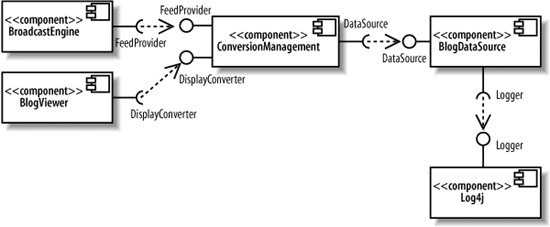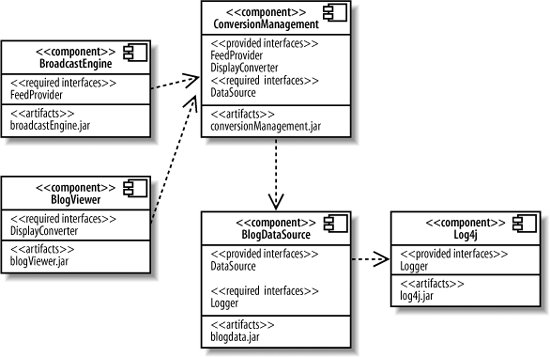Section 12.4. Showing Components Working Together
12.4. Showing Components Working TogetherIf a component has a required interface, then it needs another class or component in the system to provide it. To show that a component with a required interface depends on another component that provides it, draw a dependency arrow from the dependent component's socket symbol to the providing component's ball symbol, as shown in Figure 12-7. Figure 12-7. The ConversionManagement component requires the DataSource interface, and the BlogDataSource component provides that interface As a presentation option for Figure 12-7, your UML tool may let you get away with snapping the ball and socket together (omitting the dependency arrow), as shown in Figure 12-8. This is actually the assembly connector notation, which is introduced later in this chapter. Figure 12-8. Presentation option that snaps the ball and socket together You can also omit the interface and draw the dependency relationship directly between the components, as shown in Figure 12-9. Figure 12-9. You can draw dependency arrows directly between components to show a higher level view The second notation (omitting the interface, shown in Figure 12-9) is simpler than the first (including the interface, shown in Figure 12-7), so you may be tempted to use that as a shorthand, but keep in mind a few factors when choosing how to draw component dependencies. Remember that interfaces help components stay loosely coupled, so they are an important factor in your component architecture. Showing the key components in your system and their interconnections through interfaces is a great way to describe the architecture of your system, and this is what the first notation is good at, as shown in Figure 12-10. Figure 12-10. Focusing on the key components and interfaces in your system The second notation is good at showing simplified higher level views of component dependencies. This can be useful for understanding a system's configuration management or deployment concerns because emphasizing component dependencies and listing the manifesting artifacts allows you to clearly see which components and related files are required during deployment, as shown in Figure 12-11. Figure 12-11. Focusing on component dependencies and the manifesting artifacts is useful when you are trying control the configuration or deployment of your system |
EAN: 2147483647
Pages: 175